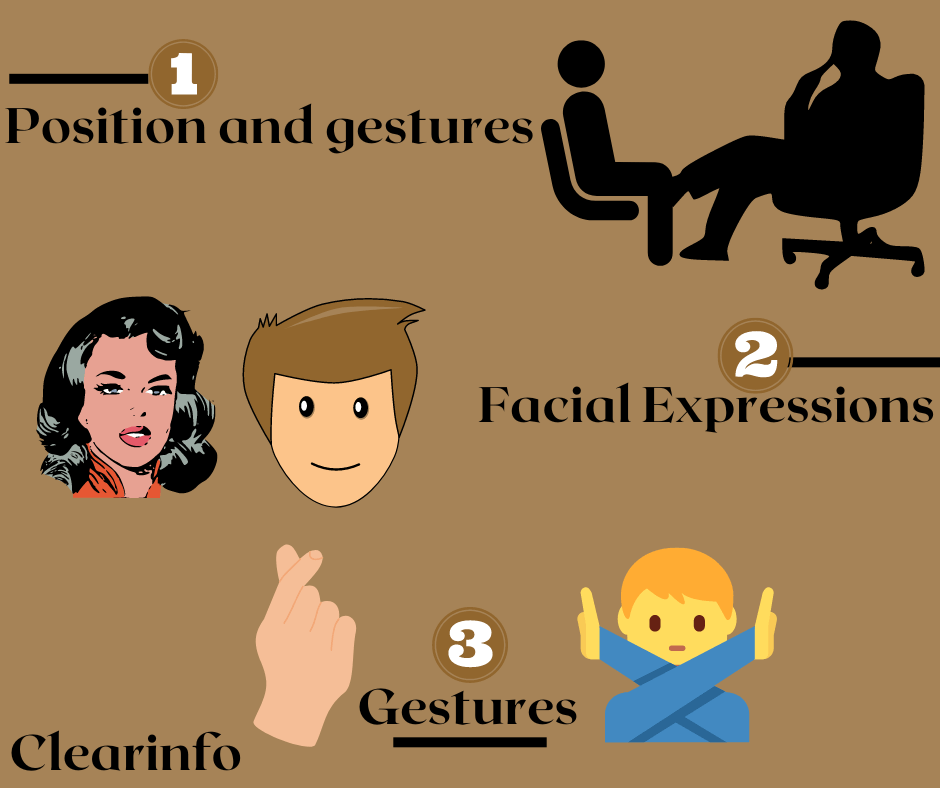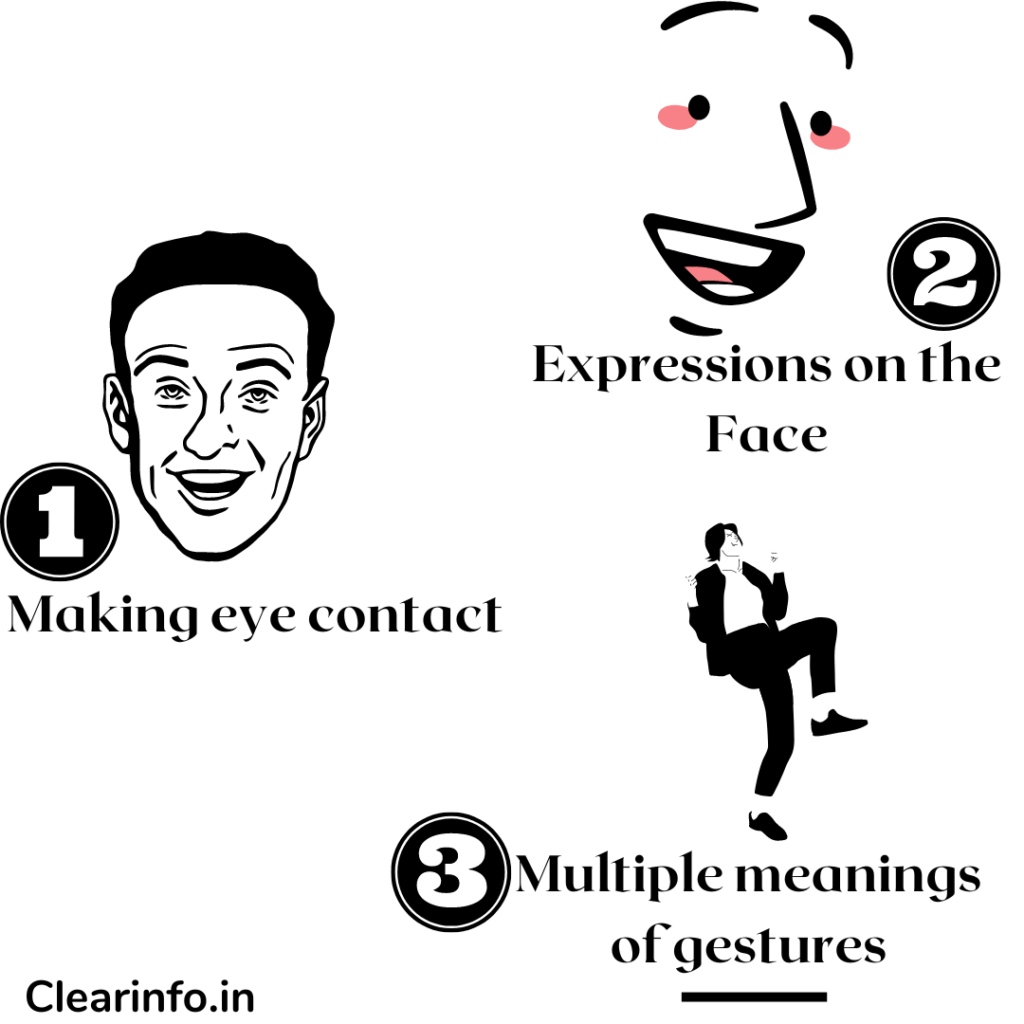Explore the advantages and disadvantages of non-verbal communication with examples and its types in addition to the challenges one can face while communicating non-verbally.
What is non-verbal communication?
Non-verbal communication refers to a form of interaction that occurs without the use of words, relying instead on non-verbal cues and behaviors. These cues encompass a wide range of elements, such as facial expressions, vocal tone, body language, gestures, silence, posture, eye contact, and touch. It is often referred to as the “silent language.”
Non-verbal communication works hand in hand with verbal communication, working together to convey the full meaning of messages. However, it’s important to recognize that non-verbal communication has its advantages and limitations.
Check out our detailed guide on: What is Non-Verbal Communication: Examples, Types & Importance
13 Advantages and disadvantages of non-verbal communication
Understanding the pros and cons of nonverbal communication is crucial for effective interpersonal interactions and successful communication outcomes.
The advantages of non-verbal communication are as follows:
1/ Enhances Verbal Communication: The foremost benefit of nonverbal communication is that it complements and enriches verbal communication. When someone is speaking, their nonverbal cues provide additional context and meaning to their words. This enhances the overall understanding of the message.
2/ Emotional Expression: Emotions can be challenging to express accurately through words alone. Nonverbal cues play a crucial role in conveying emotions. A hug, for example, can communicate comfort and support far more effectively than saying, “I’m here for you.” Similarly, tears can express sadness or empathy without the need for verbal explanations.
3/ Contextual Clues: Effective nonverbal communication provides valuable context to a conversation or situation. They help to clarify the intended meaning of verbal messages, which can sometimes be ambiguous or open to interpretation. For instance, the tone of voice and facial expressions can indicate whether a statement is meant as a joke, a question, or a statement of fact.
4/ Substituting Verbal Communication: In situations where verbal communication is not possible or appropriate, nonverbal cues become the primary means of conveying information. For example, in noisy environments, sign language for individuals with hearing impairments, or during moments of silence, nonverbal communication takes on a crucial role in maintaining effective communication.
5/ Time-Efficient: In some cases, nonverbal communication can convey information more efficiently than written or oral communication. Simple gestures, symbols, or signals can communicate complex ideas or instructions without the need for lengthy explanations. This efficiency becomes particularly valuable in time-constrained situations.
Related Reading:
6/ Personal Impressions: Nonverbal cues contribute significantly to forming initial impressions of others. Within the first few seconds of meeting someone, their body language and posture can create a lasting impact. Strong nonverbal communication skills can help individuals project confidence, approachability, and professionalism.
7/ Non-intrusive Feedback: Nonverbal cues allow individuals to provide feedback or express agreement or disagreement without interrupting the speaker. Nods smile, or facial expressions can encourage the speaker to continue or indicate understanding, while raised eyebrows can signal confusion or disagreement without needing to speak.
8/ Cultural Adaptability: Being skilled in interpreting and using nonverbal communication can help individuals adapt to different cultural norms and expectations. Different cultures have unique nonverbal communication patterns, and being aware of these differences allows for more respectful and effective cross-cultural interactions.
9/ Multi-channel Communication: Nonverbal communication adds depth and complexity to the overall communication process. When verbal and nonverbal cues align, it reinforces the credibility of the message. Conversely, inconsistencies between verbal and nonverbal expressions can signal a potential lack of authenticity.
10/ Improved Clarity via Visual Nonverbal Cues: Nonverbal communication, when complemented by visual communication, leads to improved clarity and comprehension in the communication process. By integrating visual elements with nonverbal cues, individuals can convey their intentions, emotions, and information in a manner that leaves little room for misinterpretation.
Related Reading: Advantages and disadvantages of visual communication
11/ Overcoming cultural barriers: Nonverbal communication is an essential tool for overcoming cultural obstacles and fostering understanding between individuals from diverse cultural backgrounds. Different cultures have distinct norms that can be easily misinterpreted in cross-cultural interactions. However, by being aware of and employing appropriate nonverbal cues, people can build rapport and establish meaningful connections with others regardless of their cultural differences.
12/ Assisting people with disabilities: Nonverbal communication plays a vital role in supporting physically-disabled individuals, particularly those who are deaf or have impairments. For these individuals, nonverbal cues become essential tools for effective communication. Hand gestures, eye contact, and body language enable them to express themselves and engage with others.
The disadvantages of non-verbal communication are as follows:
1/ Limited Vocabulary: The foremost limitation of nonverbal communication is that it has a limited vocabulary compared to verbal communication. While spoken language can be used to express a wide range of concepts and ideas, nonverbal cues may not cover the same breadth of expression.
2/ Absence of Feedback: Nonverbal communication lacks the direct feedback mechanism in communication that verbal communication provides. In verbal exchanges, people can seek clarification or confirmation, but in nonverbal communication, this is not as readily available, leading to potential confusion.
3/ Incomplete Communication: Nonverbal communication cannot convey all types of information. Critical details, facts, or data are best expressed through verbal or written means, which are more precise and comprehensive.
4/ Nonverbal Conflicts: There may be instances where verbal and nonverbal communication conflict, leading to confusion for the receiver. For example, if someone says they are happy while displaying signs of sadness, it can create a disconnect.
5/ Lack of Record: Unlike verbal or written communication, nonverbal cues are usually passing and do not leave a tangible record. This can pose a challenge when attempting to recall specific details or agreements at a later time, leading to potential memory lapses or disputes.
6/ Difficulty in Long-Distance Communication: Nonverbal cues are less effective in long-distance communication, such as phone calls or online messaging. Without visual cues, the subtleties of nonverbal communication may be lost.
7/ Unconscious Leakage: Nonverbal cues can reveal unintentional information about a person’s emotions or thoughts. This can be a major demerit of nonverbal communication in certain situations, as individuals may unintentionally communicate information they wish to keep private or hide.
8/ Nonverbal Conflicts: There may be instances where verbal and nonverbal communication conflict, leading to confusion for the receiver. For example, if someone says they are happy while displaying signs of sadness, it can create a disconnect.
9/ Impersonal: Over-reliance on nonverbal communication can make interactions feel impersonal, as they may lack the depth and personal touch that comes with verbal exchanges.
10/ Lack of Clarity: Nonverbal cues might not always convey the intended message clearly or precisely. Unlike verbal communication, which relies on words and grammar to convey specific meanings, nonverbal cues can be open to multiple meanings and might not effectively communicate complex ideas.
11/ Ambiguity: Nonverbal communication can be highly ambiguous and subject to different interpretations. Gestures and body language demonstrate significant variations across different cultures and individuals, leading to misunderstandings and misinterpretations.
12/ Emotional Overload: Nonverbal cues can sometimes overwhelm the intended message with excessive emotional expressions. In highly emotional situations, nonverbal communication might dominate the interaction, making it challenging to focus on the actual content of the communication.
Examples of Non-Verbal communication
Non-verbal communication plays a crucial role in our everyday interactions. Let’s explore some of the most common examples of non-verbal communication:
- Nodding our heads to indicate agreement or saying “Yes.”
- Patting someone on the back as a gesture of appreciation for their work.
- Offering a high five to express happiness or celebration.
- Waving our hands to say goodbye to others.
- Demonstrating disinterest in a conversation by avoiding eye contact.
- Using a handshake as a gesture of mutual agreement or greeting.
- Giving a warm hug to convey happiness and emotions.
These non-verbal cues enrich our communication and add depth to our expressions beyond just words.
Types of non-verbal Communication

1/ Body language: Body language refers to the gestures, movements, and postures we use to communicate without words. It includes actions like nodding to show agreement, crossing arms to indicate defensiveness, or leaning forward to display interest.
2/ Eye contact: Eye contact involves maintaining direct visual contact with someone’s eyes while engaging in a conversation. It can convey various messages, such as showing attentiveness, interest, sincerity, or even discomfort.
3/ Touch: Touch involves physical contact during communication. A comforting pat on the back can express support, while a handshake may signify a professional greeting or agreement.
4/ Hand gestures: Hand gestures involve movements of the hands and fingers to emphasize or illustrate points during communication. Common gestures like pointing, waving, or thumbs up have the potential to improve message clarity and impact.
5/ Posture: Posture involves the alignment and positioning of our bodies while sitting or moving. An upright posture can convey confidence and professionalism, while drooping might suggest a lack of interest.
Challenges with non-verbal communication

1/ Eye Contact Norms: Eye contact carries different cultural interpretations. In Western cultures, making eye contact is often associated with confidence. However, in certain regions of Asia and the Middle East, it can be seen as disrespectful or overly assertive. Additionally, gender norms play a role, as in some Eastern cultures, women may be discouraged from initiating eye contact with men, as it might be perceived as displaying power or desirability.
2/ Diverse Meanings of Gestures: Hand signals hold multiple meanings across cultures. For example, pointing towards someone else is generally considered an insult in many parts of the world, but in some regions, it is commonly used as a simple reference. Similarly, a simple nod, one of the most common gestures worldwide, can carry different cultural connotations.
3/ Facial Expressions: Facial expressions conveying emotions such as joy, sorrow, anger, and fear are universally understood. However, cultural norms influence their appropriateness in professional settings. For instance, in Japanese culture, maintaining a neutral facial expression is preferred, as displaying emotions may be perceived as putting unnecessary stress on the other person.
Importance of non-verbal communication
Nonverbal cues significantly contribute to the overall effectiveness and meaning of our communication, and here are three primary reasons why nonverbal communication is essential:
1/ Influences first impressions: Nonverbal communication plays a significant role in forming first impressions. Within seconds of meeting someone, we use nonverbal cues to assess their personality, confidence, and approachability.
2/ Provides feedback: Nonverbal cues serve as feedback mechanisms during communication. They indicate whether the listener is engaged, interested, or confused, allowing the speaker to adjust their message accordingly.
3/ Reinforces credibility and trust: Nonverbal signals can reinforce the credibility and trustworthiness of a speaker. Maintaining eye contact, having an open posture, and using appropriate gestures can build trust and make the message more persuasive.
Advantages and disadvantages of verbal communication
The advantages of verbal communication are:
1/ Flexibility and Adaptability: Verbal communication allows for spontaneous and dynamic interactions, and it is a highly adaptable component of communication. Participants can adjust their communication style, tone, and language based on the context and the needs of the conversation. This adaptability includes not only the choice of words but also includes other non-verbal components, such as body language and vocal cues.
2/ Establishing Rapport: Verbal communication fosters a personal connection between individuals. Hearing someone’s voice and engaging in a conversation helps build trust and rapport, which is especially important in building and maintaining relationships, both in personal and professional settings.
The disadvantages of verbal communication are:
1/ Limited Reach and Accessibility: Verbal communication is generally limited to direct interaction between individuals or small groups. It may not be feasible for large-scale communication or when participants are geographically apart. Additionally, individuals with hearing impairments may face challenges in fully participating in verbal exchanges.
2/ Inability to Edit or Revise: Unlike the written form of communication, where one can review, edit, and revise before sending a message, verbal communication lacks this advantage. Once spoken, words cannot be taken back, which can lead to unintended consequences if something inappropriate or harmful is said in the heat of the moment.
Must Read:
Frequently Asked Questions
Q1) What are the advantages and disadvantages of gestures?
Ans: The advantages of gestures are that it helps to build trust, control emotions, and to increase vocal vibrations in communication. The disadvantage is that some people may not pick up these signals, creating misunderstanding.
Q2) What are the advantages and disadvantages of verbal and non-verbal communication?
Ans: The advantages of verbal communication are flexibility, reliability, ease to understand, and a faster mode of communication. The disadvantages of verbal communication are misunderstanding, no time for rectification, and difficulty with lengthy messages.
The advantages of nonverbal communication are easy presentation, enhancing verbal communication, and conveying emotions. The disadvantages of nonverbal communication are that it is difficult to understand, unclear and subjective, not suitable for long conversations, difficult to express complex thoughts, and lacks accountability.
Q3) Which of the following is a method of nonverbal communication?
Ans: Different methods of nonverbal communication are gestures, facial expressions, eye contact, appearance, touch, body language, and proximity.



